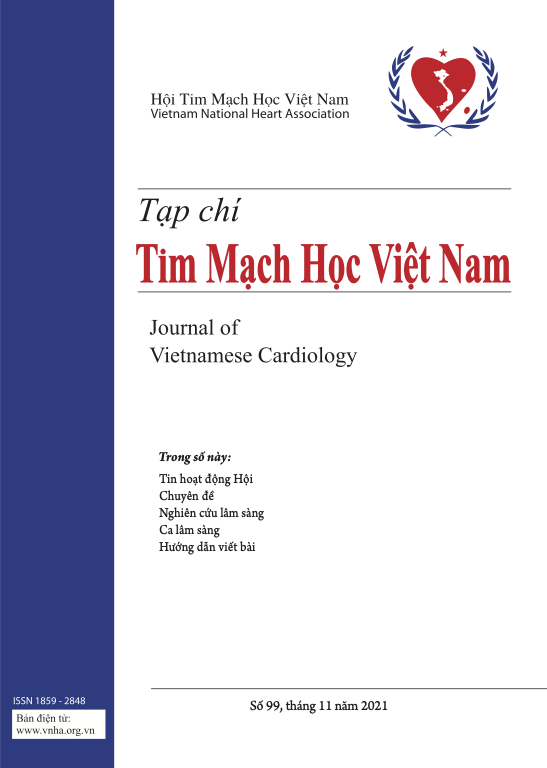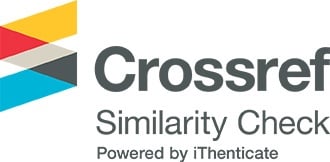Nồng độ Homocystein ở người bệnh đái tháo đường type 2 có hội chứng động mạch vành mạn
DOI:
https://doi.org/10.58354/jvc.114.2025.906Từ khóa:
Homocystein, đái tháo đường type 2, hội chứng động mạch vành mạnTóm tắt
Mục tiêu: Khảo sát nồng độ homocysteine huyết tương ở người bệnh đái tháo đường typ 2 có hội chứng động mạch vành mạn và tìm hiểu mối liên quan giữa nồng độ homocysteine với một số đặc điểm lâm sàng và cận lâm sàng của nhóm người bệnh nói trên.
Đặt vấn đề: Homocystein (Hcy) - acid amin chứa sulfur - là một sản phẩm của quá trình khử methionine và có liên quan tới quá trình hình thành mảng xơ vữa thông qua cơ chế tăng stress oxi hóa, tăng đông, tang độ dầy lớp cơ trơn mạch máu, đồng thời làm rối loạn nội mô mạch máu.1 Do đó, tăng Homocystein máu được xem là một yếu tố nguy cơ độc lập của bệnh mạch vành. 2
Đối tượng và phương pháp nghiên cứu: Đối tượng nghiên cứu là những người bệnh đái tháo đường type 2 có hội chứng động mạch vành mạn điều trị nội trú tại Bệnh viện Nội tiết Trung Ương từ 1/2023 – 10/2023.
Thiết kế nghiên cứu: Mô tả, cắt ngang.
Kết quả: 53 người bệnh (27 nam, 26 nữ, tuổi trung bình 72,4 ± 8,6 tuổi), đủ tiêu chuẩn tham gia nghiên cứu. Qua nghiên cứu chúng tôi thấy được:
- Nồng độ homocystein máu ở người bệnh đái tháo đường type 2 có hội chứng động mạch vành mạn là 14,95 ± 5,01 µmol/L, tỷ lệ tăng homocysteine máu > 15 µmol/L là 54,7%.
- Nồng độ homocystein máu ở nhóm người bệnh ĐTĐ type 2 có hội chứng ĐMV mạn và có bệnh thận mạn (MLCT < 60 ml/phút) là 16,3 ± 4,6 µmol/L, cao hơn nhóm người bệnh không có bệnh thận mạn (13,3 ± 5,1 µmol/L), và cao hơn 2,98 lần (OR = 2,98; 95%CI: 0,3 – 5,7) có ý nghĩa thống kê với p < 0,05.
- Nồng độ homocystein máu trung bình ở nhóm người bệnh ĐTĐ type 2 có hội chứng ĐMV mạn và có tiền sử ĐQN (18,3 ± 3,0 µmol/L) cao hơn nhóm người bệnh không có tiền sử ĐQN (14,3 ± 5,1 µmol/L), và cao hơn 4,07 lần (OR = 4,07; 95%CI: 0,5 – 7,6) có ý nghĩa thống kê với p < 0,05.
- Nồng độ homocystein máu trung bình ở nhóm người bệnh ĐTĐ type 2 có hội chứng ĐMV mạn và xơ vữa mạch ngoại biên (mạch cảnh, mạch chi dưới) (18,1 ± 2,6 µmol/L) cao hơn nhóm người bệnh không có xơ vữa mạch ngoại biên (13,5 ± 5,2 µmol/L), và cao hơn 4,67 lần (OR = 4,67; 95%CI: 2,0 – 7,4) có ý nghĩa thống kê với p < 0,05.
Kết luận: Nồng độ Homocystein huyết tương ở người bệnh đái tháo đường type 2 có hội chứng động mạch vành mạn trong nghiên cứu là 14,95 ± 5,01 µmol/L với tỷ lệ tăng homocysteine máu > 15 µmol/L là 54,7%. Và nồng độ homocysteine huyết tương tăng ở các nhóm đối tượng nghiên cứ có bệnh thận mạn, tiền sử TBMMN và xơ vữa mạch ngoại biên.
Tài liệu tham khảo
McCully KS. Vascular pathology of homocysteinemia: implications for the pathogenesis of arteriosclerosis. Am J Pathol. 1969;56(1):111-128.
![]()
Soinio M, Marniemi J, Laakso M, et al. Elevated plasma homocysteine level is an independent predictor of coronary heart disease events in patients with type 2 diabetes mellitus. Ann Intern Med. 2004;140(2):94-100. doi:10.7326/0003-4819-140-2-200401200-00009
![]()
Johansen OE, Birkeland KI. Preventing macrovascular disease in patients with type 2 diabetes mellitus. Am J Cardiovasc Drugs. 2003;3(4):283-297. doi:10.2165/00129784-200303040-00007
![]()
Ministry of Health. Guidelines for the diagnosis and treatment of type 2 diabetes. 2020; 8-12.
![]()
Ministry of Health. Clinical practice guidelines for the diagnosis and treatment of coronary artery disease. 2020; 65-74.
![]()
Vu KC. Study on the value of 64-slice computed tomography in the assessment of coronary artery lesions. Doctoral thesis in Medicine. Hanoi Medical University. 2013
![]()
Le KT, Ho TD. Study on the characteristics of acute coronary syndrome in patients with type 2 diabetes. Journal of Vietnamese Cardiology. 2020
![]()
Nguyen TTT. Study on plasma homocysteine levels in patients with type 2 diabetes and acute coronary syndrome. Doctoral thesis in Medicine. Military Medical Academy. 2017
![]()
Nguyen TBC, Ho AB. Study on blood homocysteine levels in patients with type 2 diabetes with coronary artery lesions at Hue Central Hospital. Journal of Clinical Medicine. 2021;67
![]()
Pham TT, Hoang TV, Truong DC. The relationship between blood homocysteine levels and certain cardiovascular risk factors in patients with type 2 diabetes. Journal of Practical Medicine and Pharmacy. 2017;175(12):109-115
![]()
Ngo DTH. Evaluation of the SYNTAX score in patients with type 2 diabetes mellitus and coronary artery disease. Master's thesis. Hue University of Medicine and Pharmacy
![]()
Tran THY, Nguyen KDV. The relationship between coronary artery disease risk according to the FRAMINGHAM score and coronary risk factors in patients with type 2 diabetes. Proceedings of the 6th National Endocrinology and Diabetes Conference. 2011
![]()
Dao TD, Nguyen TD, Cao VM. A survey of certain cardiovascular risk factors in patients with diabetes mellitus. Proceedings of the 6th National Endocrinology and Diabetes Conference. 2009
![]()
Kumar J, Ingelsson E, Lind L, et al. No Evidence of a Causal Relationship between Plasma Homocysteine and Type 2 Diabetes: A Mendelian Randomization Study. Front Cardiovasc Med. 2015;2:11. 2015. doi:10.3389/fcvm.2015.00011
![]()
Mahalle N, Kulkarni MV, Garg MK, et al. Vitamin B12 deficiency and hyperhomocysteinemia as correlates of cardiovascular risk factors in Indian subjects with coronary artery disease. J Cardiol. 2013;61(4):289-294. doi:10.1016/j.jjcc.2012.11.009
![]()
Kang SS, Wong PW, Malinow MR. Hyperhomocyst(e)inemia as a risk factor for occlusive vascular disease. Annu Rev Nutr. 1992;12:279-298. doi:10.1146/annurev.nu.12.070192.001431
![]()
Chandalia M, Abate N, Cabo-Chan AV Jr, et al. Hyperhomocysteinemia in Asian Indians living in the United States. J Clin Endocrinol Metab. 2003;88(3):1089-1095. doi:10.1210/jc.2002-021133
![]()
Hoogeveen EK. Hyperhomocysteinemia, diabetes, cardiovascular disease - The hoorn study. The Netherlands school of primary care research. 2008; 31-41
![]()
Bots ML, Launer LJ, Lindemans J, et al. Homocysteine and short-term risk of myocardial infarction and stroke in the elderly: the Rotterdam Study. Arch Intern Med. 1999;159(1):38-44. doi:10.1001/archinte.159.1.38
![]()
Peng HY, Man CF, Xu J, et al. Elevated homocysteine levels and risk of cardiovascular and all-cause mortality: a meta-analysis of prospective studies. J Zhejiang Univ Sci B. 2015;16(1):78-86. doi:10.1631/jzus.B1400183
![]()
Kwon SW, Kim JY, Suh YJ, et al. Prognostic Value of Elevated Homocysteine Levels in Korean Patients with Coronary Artery Disease: A Propensity Score Matched Analysis. Korean Circ J. 2016;46(2):154-160. doi:10.4070/kcj.2016.46.2.154
![]()
Elias MF, Sullivan LM, D'Agostino RB, et al. Homocysteine and cognitive performance in the Framingham offspring study: age is important. Am J Epidemiol. 2005;162(7):644-653. doi:10.1093/aje/kwi259
![]()
Nguyen HKN, Dang VP. A study on blood homocysteine levels in patients with coronary artery disease. Summary of research projects, 11th Vietnam National Cardiology Congress. Journal of Vietnamese Cardiology. 2005. 37-58
![]()
Cao PP. The relationship between elevated plasma homocysteine and ischemic stroke. Ho Chi Minh City Journal of Medicine. 2005;9(1):127-132
![]()
Nguyen VT, Nguyen MH, Pham VT. A study on the relationship between serum homocysteine levels and clinical features as well as CT scan findings of ischemic stroke during the acute phase. Journal of Military Pharmaco-medicine. 2015;11:91-97
![]()
Iso H, Moriyama Y, Sato S, et al. Serum total homocysteine concentrations and risk of stroke and its subtypes in Japanese. Circulation. 2004;109(22):2766-2772. doi:10.1161/01.CIR.0000131942.77635.2D
![]()
Bui TL, Doan VD, Bui MH. Characteristics of cardio-ankle vascular index in patients with type 2 diabetes with foot ulcers. VMJ. 2022;512(1). doi:10.51298/vmj.v512i1.2193
![]()








